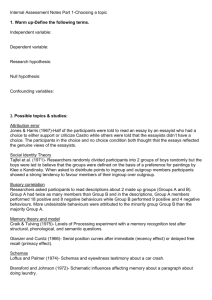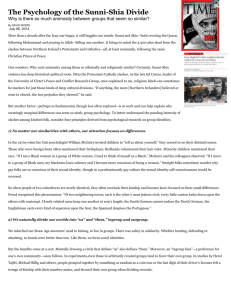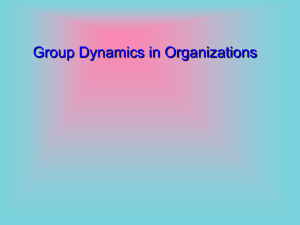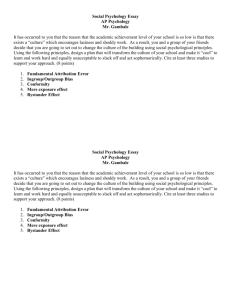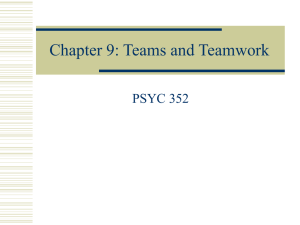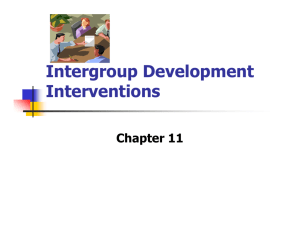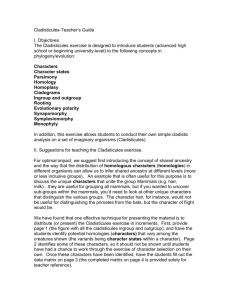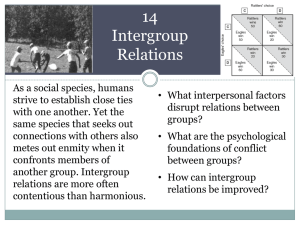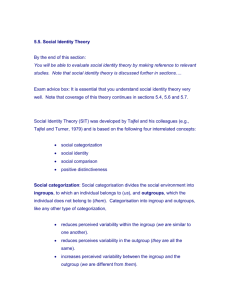Social Identification and Intergroup Behaviour: some emerging
advertisement
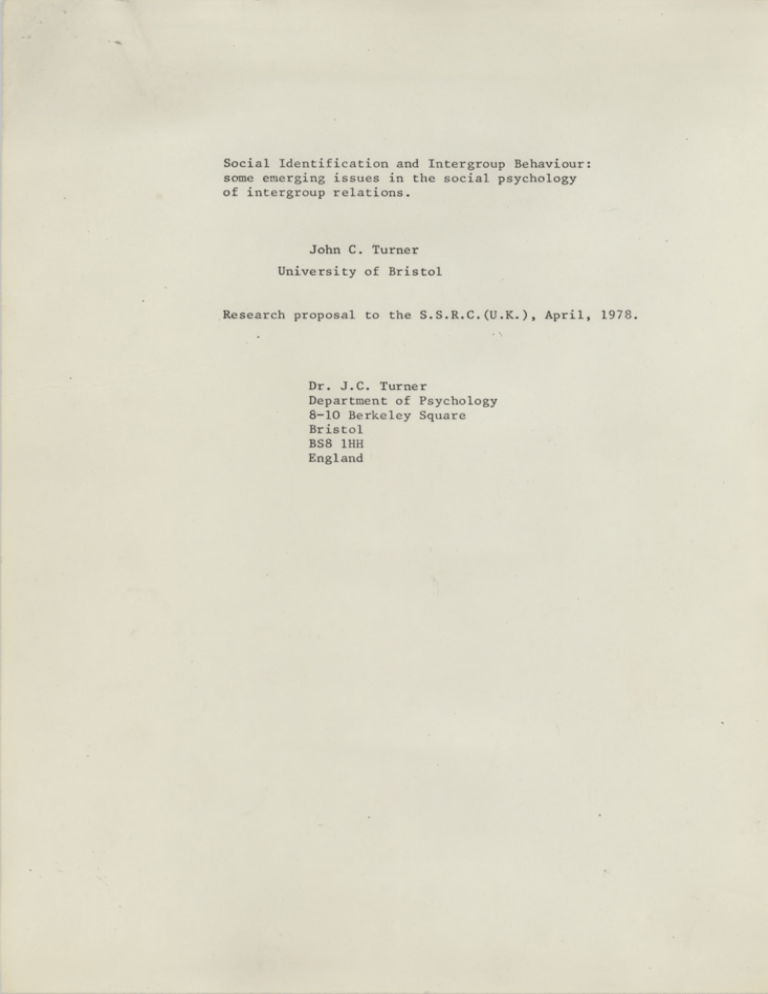
Social Identification and Intergroup Behaviour: some emerging issues in the social psychology of intergroup relations. John C . Turner University of Bristol Research proposal to the S.S.R.C.(U.K.), April, 1978. Dr. J.C. Turner Department of Psychology 8-10 Berkeley Square Bristol BS8 1HH England please typo throughout in confidence* 1 applicant Prof/Dr/Mr/Mrs/Miss 2 department 3 institution DR. surname TURNER Department of Psychology University of Bristol 4a official address 5 initials J.C . 4b o f ficial telephone number (give STD code from London) Department of Psychology, 8-10 Berkeley Square, Clifton, Bristol BS8 1HH 0272 24161 ext. 51 position held Lecturer in (Social) Psychology 6 type of application (tick appropriate boxes) project or programme □ □ new / / revised supplementary 1 1 □ Social Identification and Intergroup Behaviour 8 abstract of research (up to 150 words) Theoretical approaches in the experimental social psychology of intergroup behaviour stress the cognitive rather than affective aspects of group membership. A group is a number of people who perceive themselves to be members of the same social category. Recent experimental work is discussed to argue that this conceptualization is valid in intra- as well as inter­ group contexts. The research implications are outlined and several related experiments are proposed to investigate the conditions under which, (i) social categories are internalized when group action succeeds or fails; (ii) social contact and belief-similarity between ingroup and outgroup members improve or worsen intergroup relations; and (iii) social conformity amongst non-interacting category members increases or decreases. 9 total grant required (£) 10 proposed starling date 26,716 1st October 1978 11 proposed duration 3 years 3 P ro p o s o d in v e s tig a tio n Before completing this scction, please consider carefully the notes on page !. You do not have to con f ine yourself to the space piovided on pages 7 and 8. Ifyou do want to write more, please do so on paper the same size as this, keening within margins the same size as those on this application form, heading each p a g e 'P ro p o s e d In v e s tig a tio n (co n t'd )'. numbering tho pages in sequence and clipping them to the back of the r.pnlioation form. These pages should be submitted in duplicate. If you want tho C ouncil to consider other material (such as w oiking papeis, offprints, etc) along with the application form you should send 40 copies. Social Identification and Intergroup Behaviour: Some Emerging Issues in the Social Psychology of Intergroup Relations I. Introductory Preamble Several experiments on intergroup behaviour are proposed. The exper­ iments are quite diverse. Their unity lies in the fact that they tackle important empirical problems in the social psychology of intergroup relations from a common theoretical perspective. It is necessary, therefore, to out­ line this perspective before describing the studies themselves. The ideal procedure would be to relate the experimental social psychology of intergroup behaviour (E.S.P.I.B.) to the fifty years*research into inter­ group relations; to trace the development of the E.S.P.I.B. over the last decade, review its major theoretical orientations, pinpoint the major empir­ ical problems and elaborate the general theoretical argument of the proposal vfithin this context. The argument could then be extended in detail to cover the specific research areas intended and the theoretical hypotheses illumin­ ated with copious real-life examples to demonstrate their social relevance. The author has attempted this ideal approach and discovered t h a t , whilst it can be done, it results in a book rather than a research proposal. Instead, our survey of the E.S.P.I.B. will be cursory; just one problem will he identified to illustrate why some theoretical re-thinking is necessary; the minimum evidence will be presented to justify the re-think ing that has been done; and the social relevance of the research will remain largely implicit. Kurt Lewin is supposed to have said that there is nothing so practical as a good theory. This would seem especially true in an area such as inter­ group relations whose basic phenomena are taken directly from the problems of contemporary society. It is hoped that the theoretical ideas in this proposal are sufficiently distinctive and general that their potentially wide practical value will become clear as the argument develops. II. The Theoretical Background 1• The experimental social psychology of intergroup behaviour The E.S.P.I.B. has existed as a coherent research field for no more than a decade. At present experimenters are examining intergroup relations at three main levels: the Interactive, Evaluative, and Cognitive. These equate closely with the dominant theoretical orientations in the field: Realistic - Group - Conflict (R.C.T.J, Social Identity (S.I.T.) and Categorization (C.T.) theory. I_ Proposed investigation (cont'ts) R .C.T. (Sherif, 1966;•Rabbie, 1974) is concerned with the determinants of co-operative and competitive interaction between groups and their effects on intra- and inter-group relations. The main hypotheses are that conflicting ?roup interests create intergroup competition, whereas superordinate or colliborative goals inspire co-operation, and that competition and co-operation Lead respectively to intergroup conflict and harmony. 5.1.T. (Tajfel and Turner, in press) focusses on evaluative differences between groups as both the independent and dependent variables for intergroup comparisons. The central hypothesis is that individuals strive for favourable Lntergroup differences (differentiate the ingroup from the outgroup) in order to evaluate themselves positively in terms of their group membership. An Individual's group memberships internalized as aspects of his self-concept ire his social identity. It is assumed with C .T. that individuals define themselves in terms of social categories associated subjectively with valueLaden characteristics. C.T. (Tajfel, 1969; Doise, 1976) looks at the cognitive effects of salient, ingroup-outgroup categorizations. It proposes that, as category nemberships become salient, differences between members of the same category are minimized, whilst those between members of different categories are exaggerated. This is because individuals are assigned all the characteristics perceived to define the category as a whole. A criterial attribute or commoncategory characteristic is any property whose continuous distribution amongst individuals is to some degree correlated with, or predicted by, their discon:inuous classification as members of different social groups. I : ' i By and large, research provides empirical support for all three theories. They are complementary rather than competitive. R.C .T. and S.I.T. are dynamic, motivational theories .(S.I.T. in fact makes both cognitive and motivational assumptions) which explain actual changes in intergroup relations, whereas ^.T. is a structural, cognitive theory which explains how existing differences between groups are strengthened through their cognitive accentuation. 5.1.T. possesses the definite advantage that it takes the historical dimension of intergroup relations into account. An important determinant of contemporary intergroup relations is past intergroup relations. The research­ ers have not only explored the conditions under which 'Social comparisons lead to evaluative differentiations between groups but have also taken "comparative ; Dutcomes" (conceptualized as status or prestige differences) as the independent /ariables for further predictions. Their conclusions as to the relationship aetween status-stratification between groups and social conflict are summarized! i.n Tajfel and Turner (in press) and Tajfel (in press). Once intergroup relations are considered from a historical perspective, a very basic problem arises for both R.C.T. and S.I.T. which has, as yet, received no attention. The problem may be stated as follows: why (from a social psychological standpoint) do social groups which mediate d e f e a t , [failure, deprivation or subjective inferiority (low status) for their "members continue to exist as cohesive social units? 2- Ihe effects of failure, defeat and inferiority on social groups Ihere can be few real-life social groups which have not at some time Deen "losers". According to R.C.T. and S.I.T. any competitive struggle results! Ln both objective deprivation and subjective inferiority for the defeated group. C.T. contains the Festingerian premise (Festinger, 1950) that the basis of *roup cohesiveness is goal locomotion and associated similarity of attitudes: j Propound Jr.vastigation (cont'd) attraction to the group, indeed, the very formation of the group is due to the actual and potential rewards associated with group membership. S.I.T. hypoth­ esizes explicitly that the simplest solution to subjective inferiority is for members to leave the group which provides it - whether physically or psychol­ ogically. Thus both theories suggest that groups defeated in competition with an outgroup, that fail in some self-assigned task, should decrease in cohes­ iveness and perhaps even disintegrate. There is some experimental data that losing groups do sometimes decrease in cohesiveness, morale and motivation compared to winning groups, but there is also contrary evidence that failure (whether or not linked to defeat by an outgroup) not only does not always decrease cohesiveness but may actually increase it (see Lott and Lott, 1965, for an overview). The anecdotal evid­ ence that failure and defeat sometimes increase cohesiveness and motivation is undeniable. Oyer two thousand years ago, for example, Julius Caesar at war with the Alexandrians explained their suing for peace with the observ­ ation that "they saw that success increased the morale of our men while failure spurred them on, and they knew of no third alternative situation which could'give them the superiority in the fighting..." (Caesar, 1967, p.178). This phenomenon poses a problem not only for "intergroup" theories but also for conventional explanations o f group cohesiveness and interpersonal attraction (see Lott and Lott, 1965). .Most theorists (e.g., Lott and Lott, 1965; Berscheid and Walster, 1969) suggest that the traditional determinants of interpersonal attraction and group cohesiveness such as social interaction and attitudinal similarity operate through their "rewardingness". Failing groups patently provide their members with losses and not rewards. A partial explanati-on is provided by the concept of shared (or outgroup) threat. Shared threat Cannot be equated directly with the experience of failure, since the usual assumption is that shared threat increases ingroup cohesiveness by motivating group members to co-operate more closely to avoid failure. If the latter is the case, then clearly such co-operation loses its "raison d'etre" once failure becomes a reality. Lott and Lott (1965), however, point out that if failure is externally rather than internally attributed, if it is perceived to stem from some factor outside of the group, then it is psychologically equivalent to threat. In this case the group has not failed: it has merely received a setback; it faces some external difficulty which can be mastered, not an intrinsic defect in itself which dooms it to perpetual defeat. Thus where failure is extern­ ally attributed and so re-interpreted as threat, it will, as shared threat, combine with the hope of eventual success to motivate renewed co-operation and cohesiveness. Lott and Lott do not explain why some groups accept failure whereas others strive to attribute it externally and so transform it into threat. S.I.T. provides the most persuasive answer. Where individuals' self-concepts are closely bound up with their group membership, the attribution of failure to the group's intrinsic weakness, incompetence or inferiority would damage their self-esteem. Thus group members must attribute failure externally to maintain a positive social identity. At this point conventional theory has been taken as far as it will go and, yet, we have returned to our initial problem. Why do individuals con­ tinue to define their self-concepts in terms of social groups which mediate losses for them? Why, at the point of failure, are the bonds of group member­ ship not loosened so that individuals can protect their self-esteem by re­ defining themselves out of the group? Individuals are supposed to be bound to a group by its cohesiveness and cohesiveness is supposed to be based on ! Proposed In vestig ation (c o d I'd) the various rewards associated with group membership. The explanation of how failure can increase cohesiveness is completely circular unless we can find somethi.ng other than cohesiveness which binds individuals1 self-concepts to their group membership. This is the task we shall attempt in the research section of the proposal. Firstly, however, we must discuss more generally the nature of social gr o u p s . 3. The cognitive basis of group membership Experimental social psychology has long viewed the social group as a small ad-hoc unit whose members are in face-to-face relations of interaction, att­ raction and influence. The essence of "groupiness" is cohesiveness. As the word implies, it is that social psychological property which binds individuals together, which makes them "cohere" as a social unit. Lott and Lott's (1965) authoritative review m a k es clear that the concept represents a theory of the social group. The kernel of the theory is that social groups are based on interpersonal attraction or liking. Attraction to the group has, in practice, been operationalized as attraction to the individuals in the group. Thus, according to the theory, social groups are units of social cohesion; social cohesion equates with interpersonal attraction, and the main criterion for group formation is the affective component of inter-member attitudes: that individuals like each other. This has been a very productive model for investigating intra-group dynamics, but has always been inadequate for research into intergroup relations The subject matter of intergroup relations is the relations between members of large-scale social categories (such as national, class, racial, religious or occupational groupings), not small, face-to-face groups. S.I.T. and C . T . , for example, both emphasize the cognitive rather than affiliative-interactive aspects of group membership. A social group is defined as a number of people who perceive themselves to be members of the same social category, who share a common identification of themselves as belonging to a distinct category. Groups are based on Social Identification, not Social Cohesion. From this perspective, the primary criterion for group formation is not affective, but cognitive: individuals do not have to like each other, they must perceive themselves to be joined in common category membership. There is now experimental evidence that the Social Identification model has greater validity as a theory of "groupiness" in both intra- and inter­ group contexts. We shall concentrate on the intra-group context since it is here that the traditional model should be most applicable. Firstly, let us consider the antecedents of group membership. The relevant studies are few, but persuasive. They suggest that social cohesion is neither necessary nor 'sufficient for group formation, whereas social ident­ ification seems to be both necessary and sufficient. The studies have looked at interpersonal attraction and/or social category memberships as independent variables for group formation, as measured by the appearance of ingroup-outgroup biases in evaluation or behaviour or by intra-group altruism. Inter­ personal attraction per se is never manipulated: it is always operationalized by means of some variable such as similarity in beliefs and preferences or co-operative interaction which research has reliably demonstrated to increase liking between individuals. Two studies by Billig (Billig and Tajfel, 1973; Billig, 1973) illustrate that interpersonal similarity between ingroup members is not necessary for intergroup discrimination. Subjects were assigned to one of two minimal social categories on an explicitly random basis. There was no reason in the exper­ imental situation for individuals to like members of their own category more than members of the other. Yet subjects discriminated in favour of their 51S9/H89I D .649398 ?M 9/70 T P G p 734 11 randomly allocated,minimal ingroup over the outgroup. Other experiments demonstrate that interpersonal similarities per se are not sufficient for ingroup formation in that subjects do not favour . similar others over dissimilar others (Deutsch et. a l , 1971; Chase, 1971; burner, in press). Some studies have manipulated social category member­ ships (ingroup vs. outgroup) and interpersonal similarity (similar vs. dis­ similar others) orthogonally to each other in a 2 x 2 factorial design (Billig and Tajfel, 1973; Allen and Wilder, 1975). They find that only the former variable predicts ingroup formation. Subjects favour members of the same category, whether or not they are similar to themselves and even when they are less similar than members of the other category. In both studies subjects favour similar significantly more than dissimilar others only if the similar others are members of the same category as the subjects. Dion (1973) and Kennedy and Stephan (1977) sought to increase ingroup cohesiveness to produce intergroup discrimination. They manipulated cohes­ iveness by similarity and successful co-operation between individuals res­ pectively. There was some evidence that these variables increased inter­ personal attraction but none that they promoted favouritism towards the in­ group over the outgroup. Since the conditions of these studies were such that ingroup formation should have led to intergroup biases, we may conclude that cohesiveness did not lead to ingroup formation. Three naturalistic field experiments are especially noteworthy. Sole st_^_ _al (1973) hypothesized that altruistic helping behaviour is mediated by common category membership. They manipulated the degree of opinion-similarity I (on both important and unimportant issues) between subjects and a stranger (who needed help). With important issues, attraction to the stranger increased proportionately with his similarity, but helping increased only with 100% sim­ ilarity. When only unimportant similarities were involved, helping increased ] with similarity, but attraction did not. They conclude that attraction does not predict helping (in this situation); opinion-similarity is important in­ sofar as it allows the subject to classify the stranger unambiguously as a member of the "we-group", not insofar as it increases attraction. There seem to be at least three ways in which interpersonal attraction may be related to, but- is neither necessary nor sufficient for, group formation. Firstly, as in Sole's experiments, variables which are usually assumed to in­ crease attraction can often function independently as cognitive criteria for category formation. Variables leading to group formation which almost cert­ ainly function in this way are total or extreme similarities between people (Sole et^ al, 1973; Hensley and Duval, 1976; Moghaddam, 1977), common fate, (Rabbie and Horwitz, 1969) and shared threat (Feshbach and Singer, 1957; Burnstein and McRae, 1962). Secondly, there is plenty of evidence that variables which should increase attraction do strengthen attachment to the ingroup once a common category membership has already been established. This has been found with social or verbal interaction (Rabbie and Wilkens, 1971; Stephenson e t . al, 1976; Janssens and Nuttin, 1976), "collective encounter" (Doise and Sincl"air~1973), and opinion-similarity (Billig and Tajfel, 1973; Allen and Wilder, 1975; Moghaddam, 1977). It is not clear whether these effects are produced by increases in the cognitive salience of group membership, interpersonal attraction, or both. Thirdly, social cohesion may arise as a direct product of social identif­ ication. We may not join those we like so much as like those we perceive our­ selves joined to. This is explicable in terms of C.T. Vie infer the common characteristics of our category from its individual exemplars including our­ selves , and then assign them to all category members, again including ourselves. Thus perceived intra-group similarity is created or enhanced as a function of P rop o sed Investigation (sant't!) intra-group or self-stereotyping processes. Intra-group liking would arise from the perceived stereotypic similarity of ingroup members rather than from idiosyncratic personal similarities. (Face-to-face interaction, therefore, could sometimes decrease social cohesion by providing information which disconfirmed stereotypic similarity). This idea has never been looked at dir­ ectly, but some data tend to support it (e.g., Allen and Wilder, 1975, p . 972; Hensley and Duval, 1976; Stephan, 1977; Turner, in press). In toto, the above studies suggest that the crucial factor in group formation is social identification and not social cohesion. 4. ; Psychological depersonalization within groups In the above section, it was hypothesized that social cohesion within groups may arise as a consequence of the cognitive processes associated with social identifications. We use the individual exemplars of a category to infer its common criterial characteristics and then assign those characterist• ics to all members as category membership becomes salient. This represents the inductive and deductive aspects of the categorization or stereotyping process (cf. Tajfel, 1969, 1972) applied to ingroup members. It is well recognized that stereotyping leads to the perceptual hornogenization and depersonalization of outgroup members: such individuals become perceptually interchangeable since they are perceived in terms of their shared category attributes instead of their personal idiosyncratic qualities. Several distinctively intra-group phenomena display the same property of depersonal­ ization. The implication is that much intra-group behaviour is based on processes of self-stereotyping and hence that group membership has a strong cognitive component. Some of the characteristic consequences of common group membership are (1) perceived similarity; (2) inter-member attraction; (3) mutual regard or esteem; (*4) altruism; (5) emotional empathy or contagion; and (6) attitudinal and behavioural uniformity. Moreover, there is evidence that, as category membership is made salient, (1) perceived intra-group similarity and intra­ group liking are enhanced (Hensley and Duval, 1976; Turner, in press); (2) self and others are evaluated favourably in terms of common group membership even when own and other's individual performance was detrimental to the group outcome (Myers, 1962; Kalin and Marlowe, 1968; Kahn and Ryen, 1972); (3) others' goals and needs become motives for one's own behaviour (Horwitz, 1953; Hornstein, 1972; Sole et. a l , 1973); and (4) conformity to group norms increases without direct social influence from others (Charters and Newcomb, 1952; Doise, 1969; Sk inner and Stephenson, 1976; White, 1977). The above papers are cited beqau.se they focus more or less on the cog­ nitive salience of group membership as their independent variable and because they report data which is inexplicable in terms of interpersonal relations operating within groups. It appears that the characteristics, performances, needs, experiences and behaviours of other category members may influence our long-term or momentary stereotype of the category as a whole and thus be assigned to all category members including oneself. We paint ourselves with a brush dipped in the colours of others and vice versa and these colours may range from opinions and traits to motives and emotions. The author is aware of no evidence relating directly to emotional empathy and contagion, although the role of cognitive factors in emotional states is now well-recognized (cf. Schachter and Singer, 1962). An anecdotal example might be some racial incident where one black person is assaulted physically by one white. The result might be (and often is) that the black community as a whole seethes with anger and seeks revenge on all available whites. In other words, each black person reacts emotionally as if he or his nearest and dearest had been attacked. Each person assigns to himself the experience of his social category, which, in turn,, he infers from the experience of one 5189/839L. 0 G4939S 2M 9/70 T P Gp 734 13 Proposed Investigation (cont'd) representative exemplar. We need assume no friendship or acquaintance between the victim and other blacks for empathy and contagion to occur, nor any group pressure for emotional conformity. We need assume only that individuals act on the basis of their shared self-stereotype as circumstances make their category membership salient or relevant. Stereotyping normally refers to the perceptual or cognitive effects of salient, social identifications in relation to outgroup members (cf. Tajfel, 1969). To explain certain forms of depersonalization with groups our suggestion is that stereotyping is as applicable to ingroups as outgroups (e.g., Stephan, 1977); that stereotypic characteristics may include evaluative performances, needs and goals, emotions and attitudinal and behavioural norms as well as the well-studied personality or behavioural traits; and that the inductive and de­ ductive aspects of the categorization process may operate in a rapid and trans­ itory manner as well as in a slow and highly stable fashion. Much of this section has been speculative. However, our speculation has involved the application of a well-researched process (e.g., Ehrlich, 1973) to a body of hard data which the author would contend it is difficult to explain in any other way. The purpose has been indirect: if self-stereotyping explains certain forms of intra-group behaviour, the hypothesis is reinforced that, from a social psychological perspective, social groups are shared social identific­ ations. 5. The theoretical conclu sion Evidence concerning both the antecedents and consequences of group member­ ship suggests that groups are individuals bound by cognitive and not affective relations. Groups are based on shared social identifications and not cohesive­ ness. A social identification is basically a shared self-stereotype in terms of some category. This notion argues that the distinctive property of intraand inter-group behaviour is psychological depersonalization. Under conditions where social identifications are salient, individuals will form their self­ attitudes and act towards others on the basis of their shared category charact­ eristics and not on the basis of their idiosyncratic interpersonal similarities and differences (cf. Tajfel, 1974). Depersonalization, it should be pointed out, need not imply dehumanization (as it sometimes does in relation to hated outgroups): it is as relevant to altruism and empathy as cruelty and indiffer­ ence. Ill• 1. Research Implications, Hypotheses and Experimental Paradigms General direction for research The above discussion has three major implications for research into inter­ group relations. Firstly, to understand how social groups are formed, we need to shift our emphasis from the problem of why individuals like each other to exploring how social categories are formed and internalized as aspects of in­ dividuals' self-concepts. Secondly, to understand behavioural uniformity amongst members of largescale social categories (e.g., national, class, ethnic, etc.) we should recog­ nize that social influence is not always exerted in a direct face-to-face manner. The cognitive processes associated with self-stereotyping activity allow us to postulate a form of social influence which is distinct from both normative and informational influence as usually understood. Referent Inform­ ational Influence, as we shall call it, leads to conformity behaviour which is dependent on neither "group pressure" (normative influence) nor social compar­ isons between own and another's behaviour -in the immediate social situation (inforelational influence). 14 Proposed Investigation (cont'd) Thirdly, to find the effective determinants of intergroup conflict and harmony, we must draw a sharp distinction between interpersonal on the one hand and intra- and inter-group relations on the other. The distinction be­ tween interpersonal and group behaviour is precisely that the latter is "de­ personalized". It is based on the shared attributions to self and othei'a ef the common characteristics of their category memberships, not on the distinct­ ive idiosyncratic features of individual persons. We; need to abandon the powex’ ful myth (expressed in, for example, the Belief-Similarity and Social Contact theories of reducing prejudice) that variables which increase attract­ ion between individuals will have the same or any effects when the different •category memberships of those individuals become salient. Inter-individual interaction reflects intergroup and not interpersonal relations when category memberships are sufficiently salient. These implications will now be made more specific through concrete h y ­ potheses and experimental paradigms relevant to each area. 2. Group formation under conditions of success and failure In this section-we return to the problem posed at the outset: why do groups which fail sometimes become more cohesive? Vie hypothesize that two sets of processes underlie the internalization of social categories, social influence and attitude change on the basis of overt behaviour. By social influence, we mean simply (following, for example, K e l m a n , 1958) that credible and/or attractive communicators can persuade us to adopt a certain social definition of ourselves. In the case of an attractive source this does not imply we form a group with the communicator - it indicates that, within reason, liked others (e.g., parents) can persuade us to see ourselves in any number of ways. By attitude change, we refer to findings from the "Forced Compliance Paradigm" (cf. Harvey and Smith, 1977, p p.219-227) that we tend to bring our private attitudes in line with our public behaviour. It has been shown, too, that attitude change is sometimes negatively related to the incentives or rewards for public behaviour, i.e., the less the rewards for performing an attitudinally discrepant behaviour, the greater the tendency to change private attitudes towards justifying the behaviour. There is reasonable con­ sensus at present that both Dissonance (or Attribution) and Incentive effects can be obtained in the forced-compliance paradigm: sometimes attitudes change more with fewer incentives, and sometimes less. One variable which determines whether dissonance or incentive effects occur is the person's Freedom in choos­ ing to perform the public behaviour. It is this research area, we would sugg­ est, which provides a first answer to our initial problem. Our hypotheses are as follows: 1 Under appropriate conditions, social groups may be formed through the changing of self-attitudes on the basis of overt behaviour. Social action, however induced, on the basis of a social category membership may lead to the internalization of that category membership. H.la Where individuals freely commit themselves to behaviour on the basis of a social category, consequent identification with that category (and hence group cohesiveness) will be greater under conditions of group failure (fewer rewards) than group success (more rewards). Proposed Investigation (cont'd) H .lb Where individuals are forced to act on the basis of a social category, consequent identification (and hence group cohesiveness) with that category will be greater under conditions of group success than group failure. Thus, under certain conditions, individuals must define themselves more strongly in terms of a social category to justify the losses they have incurred. At the same time, this brings the risk of decreased self-esteem, hence they must attribute failure externally. External attribution of failure and increased cohesiveness are merely symptoms, in this account, of the increased identif­ ication which failure can create. Doubtless, this is not a complete answer, but it is a beginning. To test these hypotheses a 2 x 2 experimental design is proposed. The independent variables would be Free versus Forced Group Membership and Success versus Failure. The dependent variables would include measures of ingroup identification, cohesiveness, ingroup-outgroup attitudes and internal versus external attributions of success and failure. The procedure would involve a modification of the minimal group paradigm (Turner, in.press). Subjects would be assigned on an explicitly random basis to one of two minimal social categories. Group members would then perform individually some simple task, but the performance of each group would be evaluated as a whole. In each session, one group would succeed and one fail on the task (Success versus Failure conditions). In half the sessions, the experimenter, through instructions, would carefully induce the impression amongst Ss that they had freely accepted their category membership and chosen to contribute to its performance; in the other sessions, the Ss would perceive that they had been forced into their group membership and group activity (Free versus Forced group membership conditions). The prediction would be that attachment to the ingroup would be greater in the Free:Failure and Forced:Success than Free:Success and F orced:Failure conditions. It should be relatively easy to operationalize this paradigm with some initial piloting. Furthermore, it could be varied in simple ways to test related hypotheses. For example, later experiments could vary the interdep­ endence of ingroup and outgroup task performance to explore the conditions under which ingroup failure is externally attributed to (blamed on) the out­ group. 3. The reduction of intergroup tension This section would aim to demonstrate concretely the distinction between interpersonal and group behaviour. Specifically, experiments are proposed to test the hypothesis that the effects of belief-similarity and social contact on interpersonal relations cannot be extrapolated directly to intergroup relations. This sounds negative, but as will be seen, the experiments should contain positive pointers to the conditions under which intergroup tension can be reduced. The basic idea of the belief-similarity and social contact hypotheses (and other interpersonal theories) is that, for example, friendly interaction be­ tween ingroup and outgroup members leads to the breaking down of group bound­ aries, the abandonment of derogatory mutual stereotypes and the discovery of common values and beliefs. Thus ingroup and outgroup members should come to like each other as they like fellow ingroup members. 16 Proposed Investigation (cont'd) Our objection to this position is straight-forward. The more that friend­ ly interaction between, for instance, a black and a white person takes place on an interpersonal basis, the less capacity it v/ill have for modifying actual intergroup relations, and the less their friendship will predict their behav­ iour towards each other once their black-white category memberships become sufficiently salient. The statement: "one of my best friends is a black/Jew etc." is now a cliche for racial prejudice. Similarly it is a cliche theme of C ivil War novels and films that salient different group membei',ships can tear apart the closest of friends and families. Furthermore, the same variable, such as belief-similarity, which predicts attraction between members of the same group, may have opposite effects when two individuals identify themselves as members of different groups. Once diff­ erent category memberships are salient, the effects of a variable can only be predicted in the context of the relations between the categories. For instance, both R.C.l. and S.l.J. predict that similarity of attitudes between groups can sometimes increase competition between them - this should presumably decrease attraction between ingroup and outgroup members. Our argument, then,.is that belief-similarity and social contact between an ingroup and outgroup member will influence intergroup relations, not to the , degree that intergroup stereotypes are not employed, but only to the extent — that these variables modify those stereotypes, and that the nature of their influence will depend on existing intergroup relations. -The hypotheses are as follows: 2 Social contact between ingroup and outgroup members will modify inter- group attitudes where ingroup and outgroup members intex^act, psycholcp3ically, as group representatives, but will have no effect on intergroup attitudes where ingroup and outgroup members interact on an interpersonal basis. H2a Where ingroup and outgroup members interact as group representatives, friendly or unfriendly behaviour by the outgroup member will improve or worsen respectively the ingroup's attitudes towards the outgroup as a whole. Where ingroup and outgroup members interact on an interpersonal basis (i.e. not as group representatives), friendly or unfriendly behaviour by the outgroup member will not affect the ingroup's attitude towards the outgroup as a whole. _H3 Similarity of attitudes and beliefs between ingroup and outgroup members will improve or worsen intergroup attitudes according to the nature of the existing intergroup relationship. H3a Under conditions of intergroup competition, belief-similarity will de­ crease liking between ingroup and outgroup. tI3b Under conditions of intergroup co-operation, belief-similarity will increase liking between ingroup and outgroup. To test hypotheses 2a and 2b a 2 x 2 experimental design is proposed. The independent variables would be the Friendship versus Enmity of one out­ group member towards one ingroup member, and whether the ingroup and outgroup members interact as Group Representatives or not (Representative versus NonRepresentative). The dependent variables would be measures of attitudes to­ ward.:, ingroup and outgroup interactors, ingroup and outgroup as a whole, and estimates of ingroup and outgroup competitiveness in a mixed-motive game. 17 ' Proposed Investigation (cont'd) Ss in each session would be assigned to an ingroup which believes it is to play a mixed-motive game with an outgroup waiting in another room. One member of the ingroup will meet one outgroup member, prior to the game, for a discuss­ ion which he will then report back to the ingroup. The outgroup member will be a confederate of the experimenter, briefed to behave in either a friendly or unfriendly way. Both before and after the ingroup member's report of his dis­ cussion with the outgroup member, Ss will complete the main dependent measures. In half the conditions, the group interactors will be selected to function as group representatives (by the experimenter). In the other conditions, the interactors will be selected explicitly by chance and the experimenter will stress that they are net acting as representatives. The prediction is that attitudes towards the outgroup as a whole will be improved or worsened by the outgroup interactor's behaviour in the Representat­ ive conditions, but will be neither improved nor worsened in the Non-Represent­ ative conditions. To test hypotheses 2a and gb, the experimental paradigm would involve man­ ipulating Co-operation.versus Competition between two groups and their discovery that they have Similar versus Dissimilar task-relevant attitudes halfway through their co-operative or competitive‘ task activity. The dependent variables would be measures of task-relevant attitudes, intergroup attitudes and estimates of relative ingroup-outgroup performance on the task. Subjects would be divided into two groups and have a simple discussion task described to them. Then they would complete questionnaires about their task-relevant attitudes. Initially, the groups would work on identical tasks in the same room under either co-operative or competitive instructions. Half­ way through their discussions, they would be taken to separate rooms to con­ tinue their work in private and also to hear that both groups have either sim­ ilar or dissimilar task-rele’ vant attitudes. Once their tasks were finished, the dependent measures would be administered. The prediction would be that belief-similarity increases liking between co-operative groups but decreases liking between competitive groups. The experimental paradigms described in this section are both relatively easy to operationalize. There are no obvious conceptual or methodological problems which initial piloting should not be able to overcome. ll• Cognitive processes in social influence The experiments proposed in this section are perhaps the most ambitious theoretically and difficult methodologically, although they will make use of the well-known Asch Conformity Paradigm (cf. Harvey and Smith, 1977, p.241). Our hypothesis is that the cognitive processes associated with self-stereotyping activity give rise to a distinct form of social influence which we shall call Referent Informational. (This term has been carefully chosen for theor­ etical reasons, which need not be outlined here). Referent Informational Influence (R.I.I.), we suggest, is especially im­ portant for understanding behavioural and attitudinal uniformity amongst mem­ bers of large-scale social categories. It takes place in three stages: (i) the individual defines himself as a member of a distinct social category; (ii) the individual forms or learns the stereotypic norms of that category. He ascertains that certain ways of behaving are common criterial attrib­ utes of category membership. Certain appropriate,expected or desirable Proposed Investigation (cont'd) behav iours are used to define the category as different from other categories; (iii) the indiv idual assigns these norms to himself in the same way that he assigns other stereotypic characteristics of the category to himself when his category membership becomes psychologically salient. Thus his behaviour becomes more normative (conformist) as his category member­ ship becomes salient. Evidence has already been mentioned that the cognitive salience of one's category membership increases conformity to category norms without direct in­ terpersonal influence. It will be useful to outline very briefly how R.I.I. differs from Normativ e (N.I.) and Informational Influence (I.I.) as usually under'stood: (i ) Who is one influenced by? N.I.: people with power to reward conformity and punish deviation (usually attractive others). 1.1.: similar people who provide information about physical or social reality. R.I.I.: people who provide information about the criterial norms of one's soc­ ial category. These will usually be common category members (who need not be attractive or similar), but in some instances where ingroup members are not available, they may be persuasive outgr'oup members (e.g., the mass media, school, etc.). (i i ) What is the vehicle of social influence? N.I.: social communication from group members or "group pressure". 1.1.: social comparisons with group members. R. I.I.: social identification - the processes by which one defines oneself as a category member - forms a group stereotype on the basis of other category members' behaviour, and applies the stereotype to oneself. Interpersonal communication and comparison may be important for elaborating the stereotype, but they are not the vehicle of influence, since they are not necessary for increased conformity. / (iii) Under what conditions does conformity increase? N.I.: when one's behaviour is under surveillance by fellow group members. 1.1.: when physical or social reality is ambiguous, in some way. complex or problematic R.I.I.: when one's group membership (self-definition as a group member) is salient. (i v ) What does one conform t o ? N.I.: the observable behaviour of other group members. 1.1.: ditto. ■• R.I.I.: one's own beliefs about the appropriate behaviour for all category members (the cognitive aspects of one's attitudes towards the ingroup, i.e., one's stereotype of the ingroup). Own behaviour may become more normative at the same time as it differs from the observable behaviour of other group members. 1 cj Proposed Investigation (cont'd) . There is good reason to suppose that R.I.I. operates in the Asch Conformity Paradigm. We base ourselves here on Moscovici and Faucheux's (1972) analysis as discussed by Harvey and Smith (1977, pp. 240-247). The Asch paradigm, in which naive subjects conform to an obviously incorrect majority (confederates of the experimenter) in about 30% of t h eir responses, was designed to exclude I.I. The physical reality (lengths of lines) which Ss are judging is not ambiguous. The subject does not conform to be correct about physical reality - most subjects know the majority are wrong. Thus Asch conformity is usually presumed to indic­ ate N.I. - the subject confonris to avoid rejection by the majority and win their approbation. Anonymity is supposed to eliminate N.I. If the majority do not know who is conforming or deviating, they cannot approve the conformist or reject the deviant. Anonymously responding subjects do conform less, but not much less. Approximately 25% of responses remain conformist. As Harvey and Smith point out, most of the initial conformity remains in a situation from which, by and large, the traditional processes of social influence have been eliminated, f Moscovici and Faucheux's solution is to hypothesize that subjects use the majority's behaviour as information about the unique "response-rule" of the group, not as information about physical reality. The majority's incorrect res­ ponses inform the subject as to the distinctive norms of the group to which he now belongs. This is evidently similar to the notion of R.I.I. . In our termino l ogy, the naive subject defines himself as a member of the experimental subject group (himself and the majority): the unanimous behaviour of the majority informs him about the strange but indisputable norm of this group: since this group mem­ bership is both salient and relevant to his behaviour in this situation, he con­ forms to his beliefs about appropriate behaviour for members of this group. The subject is not concerned about being right in the abstract, nor about the others! reactions: he wants to do the right thing as a member of this group in this situat ion. Our hypotheses about R.I.I. will be formulated with specific reference to the Asch Conformity Paradigm: H •1* The greater part of Asch conformity reflects Referent Informational In­ fluence. Such conformity depends on the subject's perception that he is a m em­ ber of the same social category as the majority and that the majority's behav­ iour represents the criterial norm of that category. H •**a Where the subject and the unanimous incorrect majority belong to different social categories, conformity to the majority will decrease as category member­ ships are made salient. 1(t) Where the subject and the incorrect majority belong to the same social category, one correct ingroup responder (supporter) will decrease the subject's conformity to the majority as category membership is made salient. H -l*c Where the subject and the incorrect majority belong to the same social category, one correct outgroup responder (supporter) will not decrease the sub­ ject's conformity to the majority as category memberships are made salient. If the subject and the majority belong to different groups, the majority's responses provide him with no information about the norms of his own group. Hence he will not conform. If category memberships are not salient, the subject may tend to form a new group with the majority and so continue to conform. If the subject, majority and one supporter (a confederate who makes correct responses) all belong to the same group, the supporter provides information that 20 I | Proposed Investigation (cont’ d) incorrect responding is not a group norm. Where common group membership is not salient, the subject may tend to exclude the supporter from the ingroup and continue to conform. On the other hand, if the subject and majority belong to one group, but the supporter belongs to another, the responses of the majority and not the supporter indicate the ingroup n o r m s . Thus the supporter will not decrease conformity. Again, this effect will be weakened if the category memberships are not salient. j Two experiments are proposed. They both make use of two paradigms which are sufficiently well-established that they need not be described: the Minimal Group (cf. Turner, in press) and Asch Conformity Paradigms. Experiment 1: there will be five conditions. The Control condition will be the classical Asch procedure with one naive subject and a unanimous incorrect majority, (of experimental confederates) to establish the base line level of conformity. In the experimental conditions, all Ss will be assigned on an explicitly random basis to one of two minimal social categories. They will then take part in the Asch task. In half the conditions, the subject and the majority will be aware that they belong to the same category; in the others, subject and majority will belong to different categories. (Same versus Diff-erent-Category). In half of these conditions, the experimenter will place no stress on group memberships; in the others, he will instruct everybody to act as group representatives (Non-salient versus Salient Categories). It is predicted that conformity will increase in the order: Control < Non-Salient; Same Category < Salient ; Same Category conditions, and decrease in the order: Control > Non-Salient; Different Category > Salient; Different Category conditions. Experiment 2: there will be five conditions. The control condition will be the classical Asch procedure where one subject faces an incorrect majority with one correct supporter. The experimental subjects will again be assigned to minimal categories prior to taking part in the Asch task. They will face an incorrect majority with one correct supporter. The independent variables will be whether the supporter is in the Same or a Different Category as the subject and majority (who will always be in the same group) and whether Category mem­ berships are Salient or Non-Salient (operationalized as in Experiment 1). It is predicted that conformity will decrease in the order: Control > Non-Salient; Same Category > Salient; Same Category, and increase in the order: Control < Non-Salient; Different Category < Salient; Different Category condit­ ions . These studies should demonstrate that most Asch conformity does not depend on face-to-face pressure or support but on the subject's social identifications with others in the situation. IV Overview and Conclusion The intention is to conduct and' write up at least six major studies (exclusive of piloting) over the three years. This is a heavy workload, but should be possible since all the studies are conceptually simple and involve either1well-established or variants of well-established methodologies. Their 21 ' Proposed Investigation (cont'd) originality and value lies in the ideas behind them — which frequently bridge (important areas of social psychological theory. Furthermore, the hypotheses are easily extrapolated to real-life settings and in this sense undoubtedly possess real-world relevance and practical value. Time and effort will be primarily consumed in procuring subjects, pre­ paring materials, piloting, running experimental sessions, analysing data and writing reports, tor this reason, at least two full-time research assistants are required if the iull series of studies is to be completed. (Similarly, some occasional typing assistance will be required). The aim would be to employ two recent psychology graduates with intentions to pursue Ph.D s in related areas of social psychology, j It would be extremely useful to visit at some stage (probably at the end of the second year) one of the two centres of experimental research into intergroup behaviour (apart irom Bristol itself) in Europe. These are Utrecht University (J. Rabbie) and Geneva University (W. Doise). Both are conducting related research and an exchange of ideas would be mutually advantageous. It is difficult to choose between the two now, and the decision will probably ■'depend on various circumstances at the time, such as mutual convenience. The studies will be conducted in the order in which they have been des­ cribed at the rate of approximately two studies per year. The most time-consurning experiments, the Conformity studies, will be left to the last year. At this point, it will be possible to review the progress made, estimate the time necessary to write the final report and make a decision about whether one or both of these studies can be attempted. a Proposed Investigation ( c on t' d ) REFERENCES “le^ J ; L ' and "flder>.D -A : (1975>Intergroup Discrimination. “ Categorization, Belief-Simlarity and J . p e r s . s o c . Psychol., 32, 971-977. s i ’f 'Addison-Wesleyf (1369)' ^ . ^ s o n a l Attraction. Readihg, BllllS> M -G. (197^ )- Normative Communication in a Minimal Intergroup Situation. Eur. J. soc. Psychol., 3, 339-3 4 3 . * Taf ? 1 ’ .H - <1973)- Social Categorization and Similarity in Intergroup Behaviour. Eur. J. soc. Psychol., 3, 27-52 Burnstein E. and McRae, A.V. (1962). Some Effects of Shared Threat and Prejudice in Racially Mixed Groups. J. abnorm. soc. Psychol.. su Caesar, J. (1967). The Civil W a r . Harmondsworth, Middx. : Penguin. Charters, W.W and Newcomb,-T.M. (1952). Some Attitudinal Effects of x p c n m e n t a l l y Increased Salience of a Membership Group. In G.E Swanson, et^ al (Eds. ).: Readings in Social Psychology. New York : Holt. C" a S e c o l U ^ i v e r ^ T i Z a t i ° n 3nd A ffC C t lV e A r° U S a l- UnPUbl- P h -D' t t e s i s Deutsch, M. et^ al (1969). Social Perception of Similarity and Dissimilarity and Preferential Treatment of a Similar Person in Money Allocation Unpubl. Report. Columbia University. ' Deutsch, M. et^ al (1971). Social Discrimination on the Basis of Category Membership. Unpubl. Report. Columbia University. Dion K.L. (1973). Cohesiveness as a Determinant of Ingroup-Outgroup Bias J. pers. soc. Psychol.. 28. 1 6 3 - 1 7 1 p y p s- )01SeC o n J J - 69)*t IntergrouP Relations and Polarization of Individual and Collective Judgements. J. pers. soc. Psychol.. 1 2 , 136-146. Doise:„!:_(i19 7,6 l) - ^ ^ i c u i ^ ^ entre Groupes. Bruxelles : A. de Boeck. et les Relations --------- )°iSeGbroup r L a£el,St 1? ^ ir'/The CateSorisation Relations. Eur. (^973)J. soc. Psychol.. 3 } 1 4 5 - 1 5 7Prooess in InterIhrlich, H.J. (1973). The Social Psychology of Prejudice. ’ eshbach, S . and Singer, R. (1957). Threats upon Social Prejudice. eSti271-282.‘ (195°-). New York : Wiley. The Effects of Personal and Shared J. abnorm. soc. Psychol.. 54, 411-416. Informal Social Communication. Psych. R e v ., 57. ^ X p ^ h 911^ W -P - (r 9l V - Social Psychology ; An Attributions! Approach. Saint Louis : C.V. Mosby C o . -------- --------- ---------- :--- .Proposed In v estigation (coin'd) Hensley, V. and Duval, S. (1976). Some Perceptual Determinants of Perceived Similarity, Liking and Correctness. J. pers. soc. Psychol., 34, 159-168. ~ Hornstein, H.A. (19/2). Promotive Tension : The Basis of Prosocial Behaviour . from a Lewinian Perspective. J. Soc. Issues, 28, 191-218. Horwitz, M. (1953). The Recall of Interrupted Group Tasks : An Experimental Study of Individual Motivation in Relation to Group Goals. Hum. Re]at., ----------2, 107-112. Janssens, L. and Nutt in, J.R. (1976). Frequency Perception of Individual and Group Successes as a Function of Competition, Coaction and Isolation. J. pers. soc. Psychol. , 34_, 830-836. Kahn, A. and Ryen, A.!I. (1972). Factors Influencing the Bias towards One's. Own Group. Int. J. Group Tensions, 2, 33-50. , Kalin, R. and Marlowe, D. (1968). The Effects of Intergroup Competition, Personal Drinking Habits and Frustration in Intra-group Co-operation. Proc. 76th Ann. Conv. A . P . A ., 3, 405-406. K elman, H.C. (1958). Compliance, Identification, and Internalization : Three Processes of Attitude Change. J. Conflict Resolut. , 2 , 51-60. Kennedy, J. and Stephan, W. (1977). The Effects of Co-operation and Competition on Ingroup-Outgroup Bias. J. appl. soc. Psychol., 7, 115-130. ---— ---“ Lott, A.J. and Lott, B. E. (1965). Group Cohesiveness as Interpersonal Attraction : A Review of_ Relationships with Antecedent and Consequent Variables. Psych. B u l l . , 64, 259-309. Moghaddam, A.M. (1977). Social Categorization and Similarity : Extended Abstracts of Iwo Experiments. Unpubl. Report. University of Surrey. Moscovici, S. and Faucheux, C. (1972). Social Influence, Conformity Bias and the Study of Active Minorities. In L. Berkowitz (Ed.) : Advances in Experimental Social Psychology. (Vol.6). New York : Academic Press. Myers, A. (1962). Team Competition, Success and the Adjustment of Group Members. J. abnorm. soc. Psychol., 6 5 , 325-332. Rabbie, J.M. (1974). Effects of Expected Intergroup Competition and Co­ operation. Paper presented to Ann. Conv. A.P.A. New Orleans, U.S.A. August, 1974. University of Utrecht. Rabbie, J.M. and Horwitz, M. (1969). The Arousal of Ingroup-Outgroup Bias by a Chance Win or Loss. J. pers. soc. Psychol., 13, 269-277. Rabbie, J.M. and Wilkens, G. (1971). Intergroup Competition and its Effect on Intra-group and Inter-group Relations. Eur. J. soc. Psychol., 1, 215-234. ----------------- ~---Schachter, S. and Singer, J.E. (1962). Cognitive, Social and Physiological Determinants of Emotional State. Psych. Reiv. , 6 9 , 379-399. .... 1 f ,[} ____________________________ ____________________________________ ;__________ ^Proposed Investigation (cont'd ) i' Sherif, M. (1966). Group Conflict: and Co-operation :_Their Social Psychology. London : Routledge and Kegan Paul. Sk inner, M. and Stephenson, G.M. (1976). Group Categorization, Group Identity and thfe Polarization of Opinions. Unpubl. Ms. Working Draft. University of Nottingham. Sole, K. et. al (1973). Similarity, Attraction and Helping : Three Field Experiments Investigating the Bases of Promotive Behaviour. Unpubl. Report. Columbia University. Stephan, W.G. (1977). Cognitive Differentiation in Intergroup Perception. Sociometry, 4 0 , 50-58. Stephenson, G.M. _et. al (1976). Group Participation and Intergroup Relations : An Experimental Study of Negotiation G roups. Eur. J. soc. Psychol. , jj, 51-70. Tajfel, H. (1969). 79-97. Cognitive Aspects of Prejudice. J. soc. Issues, 25, Tajfel, H. (1972). La Categorisation Sociale. In S. Moscovici (Ed.) : Introduction 5 la Psychologie Sociale. Paris : Larousse. Tajfel, H. (1974). Intergroup Behaviour, Social Comparison and Social Change. Paper delivered at the Katz-Newcomb Lectures, University of Michigan, Ann Arbor. Tajfel, H. (Ed.) (in press). Differentiation Between Social Groups : Studies in the Social Psychology of Intergroup Relations. European Monographs in Social Psychology. London : Academic Press. Tajfel, H. and Turner, J.C. (in press). An Integrative Theory of InterGroup Conflict. In W.G. Austin and S. Worchel (Eds.) : The Social Psychology of Intergroup Relations. Monterey, California : Brooks/Cole. Turner, J.C. (in press). Social Categorization and Social Discrimination in the Minimal Group Paradigm. In H. Tajfel (Ed.). Differentiation Between Social Groups : Studies in the Social Psychology of Intergroup Relat ions. European Monographs in Social Psychology. London : Academic Press. f/hite, M.J. (1977). Counter-normative Behaviour as Influenced by De-Indiv­ iduality Conditions and Reference Group Salience. J. soc. Psychol., 103, 75-90.
